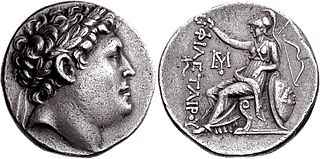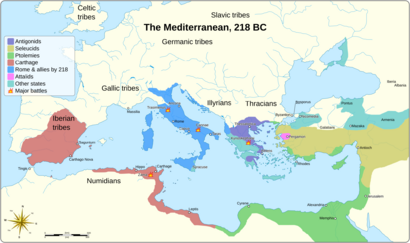Attalus I facts for kids
Quick facts for kids Attalus I Soter |
|
|---|---|
| Basileus | |
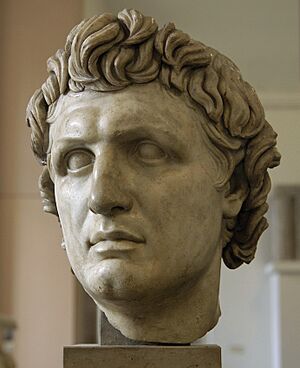
Marble head found at Pergamon dated to the 3rd century BC, currently at the Pergamon Museum in Berlin; hypothesized to be depicting Attalus I.
|
|
| King of Pergamon | |
| Reign | 241–197 BC |
| Predecessor | Eumenes I |
| Successor | Eumenes II |
| Born | 269 BC |
| Died | 197 BC (aged 72) |
| Spouse | Apollonis of Cyzicus |
| Issue |
|
| Greek | Άτταλος Α΄ Σωτήρ |
| Dynasty | Attalid dynasty |
| Father | Attalus |
| Mother | Antiochis |
Attalus I (Ancient Greek: Ἄτταλος), also known as Soter (meaning "Savior"), was a powerful ruler of the ancient Greek city of Pergamon (now in Turkey). He ruled the Pergamene Kingdom from 241 BC to 197 BC. Attalus was the adopted son of Eumenes I, the previous ruler. He was the first of the Attalid dynasty to officially call himself a king, which he did around 240-235 BC.
Attalus became famous for a major victory against the Galatians. These were Celtic tribes from Thrace who had been attacking and demanding money from many parts of Asia Minor for years. His victory was celebrated with a special monument in Pergamon, which included the famous sculpture The Dying Gaul. After this win, Attalus took the name "Soter" (Savior) and the title of king.
He was a loyal friend to the Roman Republic and helped them in the first and second Macedonian Wars against Philip V of Macedon. Attalus also led many naval battles in the Aegean Sea. He gained the islands of Aegina and Andros for Pergamon. During his rule, Pergamon also had many conflicts with the nearby Seleucid Empire.
Attalus saw himself as a protector of Greek cities and a champion of Greeks against "barbarians." He spent money on art and monuments in Pergamon and in other Greek cities he wanted as allies. He died in 197 BC at age 72, shortly before the end of the Second Macedonian War. He and his wife, Apollonis, were known for raising their four sons well. His son, Eumenes II, became king after him.
Contents
Who Was Attalus I?
Little is known about Attalus's early life. He was Greek. His father, also named Attalus, was the son of a brother of Philetaerus, who founded the Attalid dynasty. Philetaerus was also the uncle of Eumenes I, who Attalus I later succeeded. Attalus's father was famous for winning a chariot race at Olympia.
Attalus's mother, Antiochis, was likely related to the Seleucid royal family. Her marriage to Attalus's father was probably arranged to strengthen the Attalid family's power. Attalus's father died before 241 BC. Attalus was then adopted by Eumenes I, the current ruler. When Eumenes I died in 241 BC, Attalus became the ruler of Pergamon.
Victory Over the Galatians
One of the most important events in Attalus's early reign was his battle against the Galatians. The Greek writer Pausanias said that defeating the "Gauls" (another name for the Galatians) was Attalus's greatest achievement.
The Galatians were Celts who had moved from Thrace and settled in Galatia in central Asia Minor. For a long time, they had caused problems for Pergamon and other parts of Asia Minor. They would demand money from rulers to avoid war. Earlier rulers, including Eumenes I, had paid this "tribute." However, Attalus refused to pay.
Around 238–235 BC, the Galatians attacked Pergamon. Attalus met them near the Caicus River and won a major victory. This battle is known as the Battle of the Caecus River.
This victory brought Attalus great respect. He took the name Soter, meaning "savior," just like Antiochus I had done. He also declared himself basileus, or king. This formal step showed that he was no longer under the rule of the Seleucid Empire. The victory became a central part of Attalus's fame. He presented himself as a champion of the Greeks against barbarians. He ordered many artworks and sculptures to celebrate himself and Pergamon's win.
Pergamene coins usually showed Philetaerus, the dynasty's founder. After the victory over the Galatians, around the 230s BC, Philetaerus's image on the coins changed. He was shown with a laurel wreath, a symbol of victory.
Pausanias also wrote about an old prophecy that supposedly predicted this great victory:
Then having crossed the narrow strait of the Hellespont,
The destructive army of the Gauls shall pipe; they shall lawlessly
Ravage Asia; and God shall make it yet worse
For all who dwell by the shores of the sea
For a little while. But soon the son of Cronus shall stir up a helper for them,
A dear son of a Zeus-reared bull
Who shall bring a doom on all the Gauls.
Pausanias explained that "son of a bull" meant Attalus, because he was called "bull-horned." A monument was built on the acropolis of Pergamon to celebrate this battle. It included the famous sculpture The Dying Gaul.
Battles with the Seleucid Empire
After his victory over the Galatians, Pergamon faced new challenges from the Seleucid Empire. The Seleucid ruler of Asia Minor, Antiochus Hierax, allied with the Galatians and attacked Pergamon. Attalus defeated them in several battles, including the Battle of Aphrodisium. He also won three more battles against Antiochus Hierax's forces alone.
These victories gave Attalus control over much of Seleucid Asia Minor north of the Taurus Mountains. However, this control was not always strong. Around 226–223 BC, Attalus built a monument on the acropolis of Pergamon to celebrate his battlefield wins.
In 223 BC, Seleucus III Ceraunus, the Seleucid king, was killed. Achaeus took control of the Seleucid army. He was offered the kingship but refused, choosing to serve Antiochus III the Great, Seleucus III's younger brother. Antiochus III made Achaeus governor of Seleucid Asia Minor. Achaeus quickly won back many lost territories for the Seleucids. Within two years, he had pushed Attalus back to the city walls of Pergamon.
However, in 220 BC, Achaeus rebelled against Antiochus III and declared himself king. This was good news for Attalus. In 218 BC, Attalus, with the help of some Thracian Gauls, recaptured his old territories in Western Asia Minor. This made Pergamon a strong power in the region.
Achaeus returned from his own campaigns in 217 BC and continued fighting Attalus. Then, in 216 BC, Antiochus III attacked Achaeus. Antiochus besieged Sardis, Achaeus's capital, and captured the city in 214 BC. Achaeus was eventually captured and killed. By 213 BC, Antiochus III had regained control of all his eastern provinces in Asia Minor.
The First Macedonian War
Attalus had formed an alliance with the Aetolian League, a group of Greek states in central Greece. He helped pay for defenses in their strongholds. This alliance led Attalus into conflict with Philip V of Macedon, the powerful king of Antigonid Macedonia. This conflict became the First Macedonian War. Attalus wanted to improve his reputation in the region. He also funded art and monuments, like a stoa (a covered walkway) at Delphi.
In 215 BC, Philip allied with Hannibal of Carthage, which worried Rome. Rome was already fighting the Second Punic War. In 211 BC, Rome signed a treaty with the Aetolian League, which included Attalus as an ally. Attalus was even chosen as one of the two generals (strategoi) of the Aetolian League for 210/209 BC. In 210 BC, his troops helped capture the island of Aegina, which Attalus used as a base in Greece.
In 209 BC, Philip marched south into Greece. The allies lost two battles. Attalus arrived in Greece in July 209 BC and met with the Roman general P. Sulpicius Galba on Aegina. In the summer of 208 BC, Attalus personally led a combined fleet of Pergamene and Roman ships. They tried to take the Macedonian island of Lemnos but failed. Instead, they attacked and looted the island of Peparethos.
Later, the Romans attacked and looted two cities, Oreus and Opus. While the Roman general returned to Oreus, Attalus stayed to collect spoils from Opus. Philip's forces surprised Attalus and his troops at Opus. Attalus barely escaped to his ships, leaving his weapons behind.
After this retreat, Attalus learned that Prusias I, king of Bithynia and a relative of Philip V, had attacked Pergamene territory. Attalus returned to Asia to deal with this. Soon after, the Romans also left Greece to focus on Hannibal. In 206 BC, the Aetolians made peace with Philip. A treaty was signed in 205 BC, ending the war. Attalus kept Aegina, but his role in the war was "rather ineffective." The conflict between Pergamon and Bithynia also ended.
Bringing the Great Mother Goddess to Rome
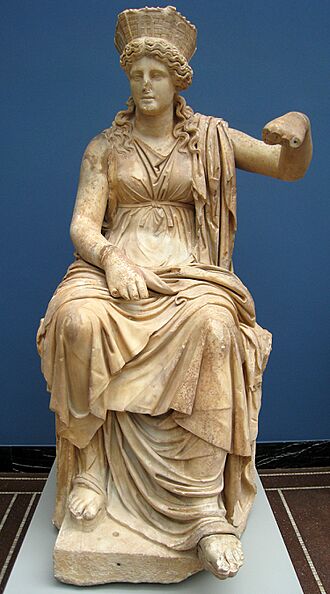
In 205 BC, after the peace treaty, Rome turned to Attalus for help with a religious matter. The Second Punic War against Carthage was still ongoing. Roman priests consulted ancient prophecies, which said that if a foreign enemy attacked Italy, they could be defeated if the Mater Deum Magna Idaea, the Great Mother Goddess, was brought to Rome. There had also been many meteor showers, which was seen as a sign.
A Roman group traveled to Pergamon to ask Attalus for help in getting a special artifact for Rome. According to the historian Livy, Attalus welcomed them warmly. He "handed over to them the sacred stone which the natives declared to be 'the Mother of the Gods', and bade them carry it to Rome." This ancient goddess, Cybele, was brought to Rome as the Magna Mater, and the stone was believed to be a meteorite.
There are different stories about where the stone came from. Some say it was found on Mount Ida, near Pergamon. Others say it came from Pessinus, a city far inland where Pergamene influence was weak. It's unclear if this was a mistake by Roman writers or if Attalus had good relations with the local tribes there.
Conflicts with Macedon in 201 BC
After the peace treaty, Philip V of Macedon wanted to expand his power in the Aegean Sea and Asia Minor. In 201 BC, he captured Samos and the Egyptian fleet stationed there. He then attacked Chios. These actions led Attalus, along with Rhodes, Byzantium, and Cyzicus, to join the war.
A large naval battle took place near Chios. During the fight, Attalus became separated from his fleet and was chased by Philip. He had to run his three ships ashore. He narrowly escaped by leaving royal treasures on the decks of his ships, which distracted his pursuers who stopped to plunder.
That same year, Philip invaded Pergamon. He couldn't capture the city because Attalus had strengthened its defenses. However, Philip destroyed the temples and altars around the city. Meanwhile, Attalus and Rhodes sent messengers to Rome to complain about Philip's actions.
The Second Macedonian War
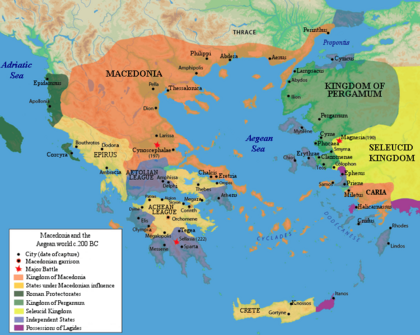
In 200 BC, Attalus became involved in the Second Macedonian War. When people from Acarnania, supported by Macedon, invaded Attica, Athens asked for help from Philip's enemies. Attalus, with his fleet at Aegina, was invited to Athens. He also learned that Roman ambassadors were there, so he decided to visit. The Athenians were desperate for allies, and they gave him an amazing welcome. The historian Polybius wrote:
... in company with the Romans and the Athenian magistrates, he began his progress to the city in great state. For he was met, not only by all the magistrates and the knights, but by all the citizens with their children and wives. And when the two processions met, the warmth of the welcome given by the populace to the Romans, and still more to Attalus, could not have been exceeded. At his entrance into the city by the gate Dipylum the priests and priestesses lined the street on both sides: all the temples were then thrown open; victims were placed ready at all the altars; and the king was requested to offer sacrifice. Finally they voted him such high honors as they had never without great hesitation voted to any of their former benefactors: for, in addition to other compliments, they named a tribe after Attalus, and classed him among their eponymous heroes.
Two Athenian tribes had recently been renamed, so there was an opportunity to honor Attalus. A district (deme) was also named after Apollonis, Attalus's wife.
The Roman consul, Sulpicius Galba, convinced Rome to declare war on Philip. He asked Attalus to join the Roman fleet and attack Macedonian lands in the Aegean again. In the spring of 199 BC, the combined fleets of Pergamon and Rome captured Andros. The Romans took the spoils, and Attalus gained the island.
From Andros, the Pergamene forces sailed on an expedition. They attacked Kithnos but failed. They then sailed north, gathered food from Skiathos, and continued to Mende. The Pergamenes attacked Cassandrea by land but were defeated. They continued northeast to Acanthus, which they looted. Their ships then returned to Euboea with the spoils.
Attalus and the Romans then met with the Aetolians. The Aetolians asked Attalus for a thousand soldiers, but he refused. He reminded them that they had not helped him when Philip attacked Pergamon two years earlier. Attalus and the Romans then attacked Oreus but failed to take it at first. They left a small force to surround the city and sailed to Thessaly. Attalus attacked Pteleum, while the Romans attacked Larissa Cremaste. When they returned to Oreus, they had siege equipment ready, and the city fell. The Romans enslaved the captives, while the Attalids looted and occupied the city. The campaigning season ended, and Attalus returned to Pergamon.
In the spring of 198 BC, Attalus returned to Greece with twenty-three ships. He joined a fleet of twenty Rhodian ships at Andros to finish conquering Euboea. Soon, the Romans joined them, and the combined fleets captured Eretria and later Carystus. This meant the allies controlled all of Euboea except for Chalcis.
The allied fleet then sailed to Cenchreae to prepare for an attack on Macedonian Corinth. Meanwhile, the new Roman consul, Titus Quinctius Flamininus, learned that the Achaean League, allies of Macedon, had a new leader who favored Rome. Attalus's relationship with the Aetolian League had become strained. So, improving relations with the Achaeans could bring a new ally.
Hoping to convince the Achaeans to leave Philip and join the allies, messengers were sent, including Attalus himself, to Sicyon. They offered to include Corinth in the Achaean League. Attalus won the support of the Sicyonians by buying land sacred to Apollo for them. They even built a huge statue of him in their marketplace. Later, Attalus gave more gifts to Sicyon, leading the city to hold yearly animal sacrifices in his honor.
A meeting of the Achaean League was held. After a heated debate, the remaining delegates agreed to join the Roman alliance. Attalus led his army from Cenchreae and besieged Corinth from the north. The Romans moved their forces to the east, and the Achaeans held the west. However, Corinth's defenders held strong. Macedonian reinforcements arrived, and the siege was abandoned. Attalus and his army sailed to Piraeus.
Also in 198 BC, a new conflict began with the Seleucid Empire. King Antiochus III seemed to take advantage of Pergamon's focus on the Macedonian War. He attacked while Pergamon's defenses were weak, threatening its lands in Asia Minor.
Back in Greece, in early 197 BC, Flamininus called Attalus to join him at Elateia. From there, they traveled to a Boeotian council in Thebes to encourage Boeotia to join the Roman side. At the council, Attalus spoke first, reminding the Boeotians of all the good things he and his ancestors had done for them. But during his speech, he suddenly stopped talking and collapsed, with one side of his body paralyzed. Attalus was taken back to Pergamon, where he lived for a few more months. He died around the time of the Battle of Cynoscephalae, which ended the Second Macedonian War.
By the end of his reign, Attalus's kingdom was "hardly any bigger than it had been at the beginning." Antiochus III had taken large parts of Pergamene territory. Attalus's son and successor, Eumenes II, faced a difficult situation. However, Attalus had made Pergamon a great center of art and learning. He also earned the respect of the Romans and others. Historian Esther Hansen called Attalus's reign not only the longest of any Attalid king but also "the most laudable."
Attalus's Family Life
Attalus married Apollonis, who was from Cyzicus. They had four sons: Eumenes, Attalus, Philetaerus, and Athenaeus (named after Apollonis's father). Apollonis was seen as a wonderful mother. Polybius described her as "a woman who for many reasons deserves to be remembered, and with honor. Her claims upon a favourable recollection are that, though born of a private family, she became a queen, and retained that exalted rank to the end of her life, not by the use of meretricious fascinations, but by the virtue and integrity of her conduct in private and public life alike."
Ancient writers often praised the strong bond between the brothers and how well they were raised. A decree from Antiochus IV praised "king Attalus and queen Apollonis ... because of their virtue and goodness, which they preserved for their sons, managing their education in this way wisely and well." An inscription at Pergamon shows Apollonis saying that she was always thankful to the gods, not for wealth or power, but because she saw her three sons protecting the eldest, and him ruling without fear.
When Attalus died in 197 BC at age 72, his eldest son, Eumenes II, became king. Polybius wrote, "what is more remarkable than all, though he left four grown-up sons, he so well settled the question of succession, that the crown was handed down to his children's children without a single dispute." The fact that the dynasty avoided family fights and scandals helped them gain legitimacy and authority.
Apollonis died in the mid-second century BC. In her honor, Attalus's sons built a temple in Cyzicus. It was decorated with carvings showing scenes of sons showing love for their mothers, and one scene also showed love for a father.
See Also
Images for kids


